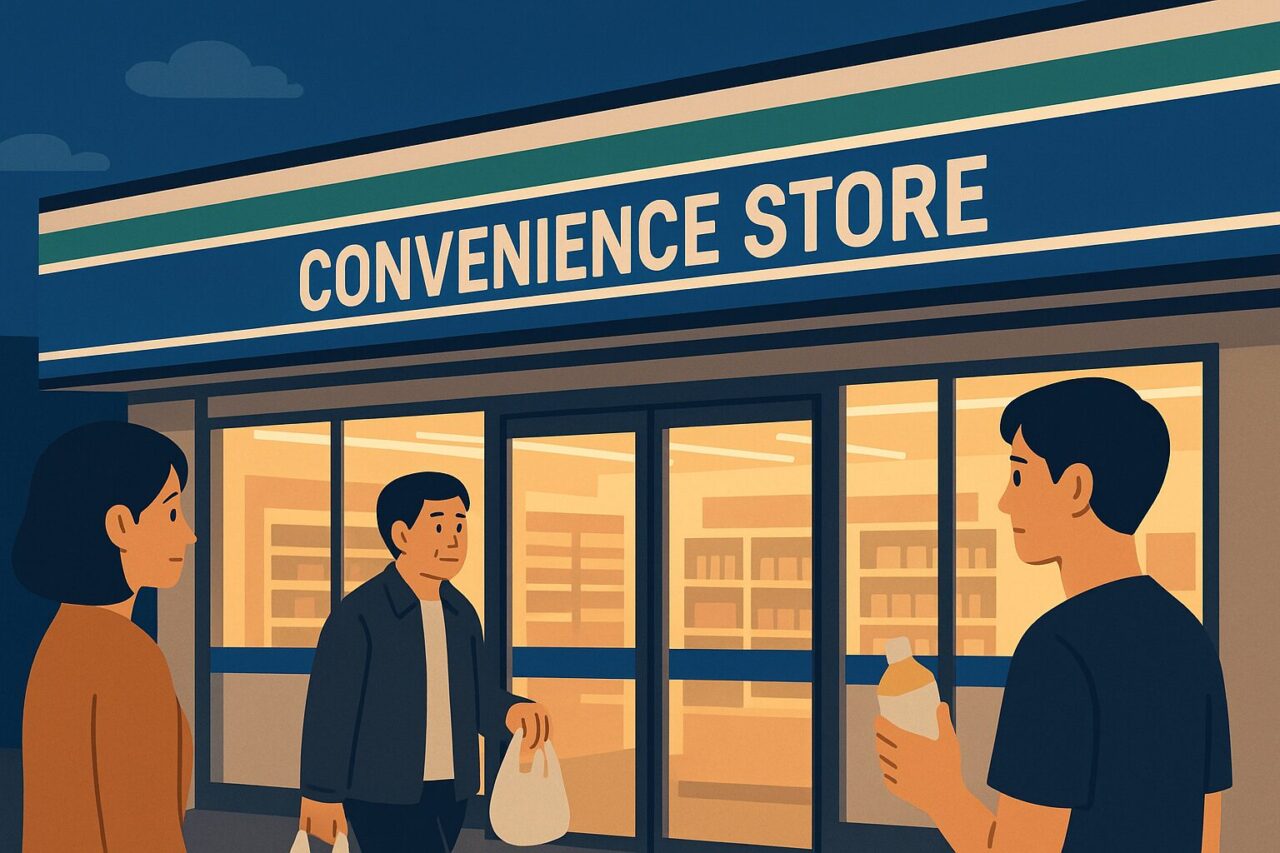
- Introduction: The Global Praise for Japanese Convenience Stores – But What Are We Overlooking?
- Chapter 1: What Surprises Foreign Tourists About Japanese Convenience Stores?
- Chapter 2: The Human Warmth Once Found in Japanese Convenience Stores
- Chapter 3: Why Are Japanese People Moving Away from Convenience Stores?
- Chapter 4: Why Convenience Stores Still Play an Irreplaceable Role in Japan
- Chapter 5: Rediscovering the Charm of Japanese Convenience Stores Through Foreign Eyes
- Chapter 6: Rethinking the Role of Convenience Stores in Modern Japanese Life
- Chapter 7: Rebuilding the Human Touch in Japanese Convenience Stores
- Final Thoughts: Rethinking the Role of Convenience Stores in Our Lives
Introduction: The Global Praise for Japanese Convenience Stores – But What Are We Overlooking?
In recent years, it’s become increasingly common to hear foreign tourists express how “amazing” Japanese convenience stores are. Social media and travel review sites are filled with posts like:
“7-Eleven’s rice balls are the best in the world!”
“FamilyMart’s fried chicken brought me to tears!”
“Lawson’s sweets taste like something from a luxury restaurant!”
There’s no doubt that Japanese convenience stores are something to be proud of. However, for many Japanese people, these glowing comments evoke a certain sense of confusion—or even discomfort.
“Really? Are they that good?”
“Come to think of it, I haven’t been to one in a while…”
Indeed, among Japanese consumers, a trend of moving away from convenience stores—sometimes called “konbini banare,” or “convenience store distancing”—has gradually emerged.
Why is it that what feels like everyday routine for Japanese people feels like an amazing discovery for foreign tourists?
In this article, we will explore that gap in perception, tracing the historical role of convenience stores in Japanese life, the changes in usage habits, and the evolving function of these stores in society. We’ll also examine the possibility of rediscovering their value, not just as places of consumption, but as social infrastructure.
Chapter 1: What Surprises Foreign Tourists About Japanese Convenience Stores?
Let’s begin by exploring what exactly foreign tourists find so impressive about Japanese convenience stores.
1.1 Cleanliness and Order: An Uncommon Global Standard
Japanese convenience stores are extremely clean and tidy compared to other countries around the world. The shelves are beautifully displayed, there is not a speck of trash on the floor, the lights are bright even at night, and the stores are quiet and calm.
When compared to convenience stores in Asian cities or parts of Europe and the United States, for example, this truly makes it seem like a different world.
In many parts of the world, convenience stores have a negative image: low prices, but dirty, unsafe, or poorly maintained. Against that backdrop, stepping into a Japanese konbini can feel like walking into the future.
1.2 A Stunning Variety of High-Quality Products
The sheer range and quality of food in Japanese convenience stores is also a major source of amazement.
Take rice balls (onigiri), for example. In addition to standard fillings like tuna mayo or pickled plum, there are regional specialties such as grilled mentaiko or beef yakiniku.
Many tourists are surprised by how tasty and fresh they are, even though they are mass-produced and relatively inexpensive.
Brands like 7-Eleven’s “Gold Series,” FamilyMart’s “Famichiki,” and Lawson’s “Uchi Café” line offer everything from gourmet frozen meals to premium desserts that rival what you’d find in a proper restaurant. Foreign visitors often express astonishment that such quality is available at a convenience store.
1.3 Multifunctional Services, All Day, Every Day
Perhaps the biggest surprise for many foreign tourists is the range of services available—many of them 24/7.
- ATMs with multilingual support
- Courier and package pickup/drop-off services
- Copying, scanning, faxing
- Payment of utility bills and taxes
- Ticket purchasing and public Wi-Fi
The fact that these services are available at virtually any time of day, and in so many locations, gives tourists the impression that Japanese convenience stores are “compact life hubs” or mini urban centers.
Chapter 2: The Human Warmth Once Found in Japanese Convenience Stores
While foreign visitors are often captivated by the modern features of today’s convenience stores, many Japanese people recall a different, warmer era of the konbini. It was once a space not only of convenience but of human connection.
2.1 Familiar Faces and Unspoken Understanding
Not long ago, it was common for customers to frequent the same store regularly, forming relationships with the staff.
For example:
A regular customer buying cigarettes might find the clerk preparing their usual brand even before they said a word.
A friendly “Good morning” or “Working late again?” would be exchanged without pretense.
Local teens or housewives often worked at these stores, creating a sense of community and familiarity.
Many stores were franchise-owned, often by local residents who treated their store not merely as a business, but as part of the neighborhood. In this way, convenience stores became more than just places to buy things—they became part of the social fabric.
2.2 Konbini as a Casual Social Hub
Convenience stores once served as an informal gathering space—a miniature social arena embedded within daily life.
- Kids stopped by for snacks after school.
- Night-shift workers grabbed a can of coffee and chatted a bit before heading home.
- Elderly customers exchanged a few words with the clerk while buying a newspaper.
In these small, fleeting moments, the konbini became a “connector” in the local community—not just a store, but a place of interaction.
But that warmth is fading.
Today, many stores are staffed by part-timers who rotate frequently, including a large percentage of foreign workers who, while hardworking, may face language barriers or cultural differences that limit casual conversation.
This shift, while understandable in the face of labor shortages and operational demands, has altered the emotional texture of the convenience store. What was once a warm and familiar place has, for many, become a cool and transactional space.
Chapter 3: Why Are Japanese People Moving Away from Convenience Stores?
Despite their global praise, many Japanese consumers are quietly distancing themselves from convenience stores. This isn’t due to any single factor, but rather a mix of economic, cultural, and technological shifts.
3.1 Perceptions of Higher Prices
Many consumers now perceive convenience stores as expensive.
Why pay ¥150 for a bottle of tea when the same product costs ¥98 at a nearby drugstore?
Similar comparisons apply to snacks, frozen meals, and even daily essentials. For cost-conscious consumers, especially amid rising inflation and stagnant wages, this “price gap” feels harder to justify.
Convenience, once worth paying for, now feels like a premium not everyone is willing to pay.
3.2 Health-Conscious Lifestyles and the Rise of Home Cooking
There’s also a growing belief that convenience store food is unhealthy—too salty, too sugary, too processed. With increasing awareness of nutrition and food safety, many people now prefer cooking at home or subscribing to healthy meal delivery services.
Younger families, middle-aged professionals, and even elderly individuals are embracing:
Meal kits
Organic groceries
“Additive-free” or “low-sodium” food options
In this new health-conscious era, konbini meals are often seen as “last resort” options, rather than everyday staples.
3.3 Digital Alternatives to Physical Shopping
The convenience store’s role as a utility payment center, ATM, and courier drop-off point is also being eroded by digital alternatives.
Online banking replaces ATM trips
App-based utility payments replace in-person billing
Food delivery services and online grocery platforms reduce the need to “pop in” for quick meals
The rise of non-contact, on-demand consumption is slowly but surely reducing the day-to-day reliance on physical convenience stores.
Chapter 4: Why Convenience Stores Still Play an Irreplaceable Role in Japan
In recent years, a growing number of people—especially in urban areas—have started saying, “Maybe we don’t even need convenience stores anymore.” But is that really true?
This idea may apply to people who live in large cities, have internet access, and enjoy multiple shopping options. However, for many others in Japan, convenience stores remain an indispensable part of life.
4.1 A Lifeline for Rural Communities
In suburban and rural areas, the situation is drastically different.
- Supermarkets may be several kilometers away, accessible only by car.
- Post offices and banks may have limited hours or be far from home.
- Elderly residents may not use online shopping or digital services at all.
For people in such environments, the local convenience store serves as the last and only nearby source for groceries, cash, daily necessities, and information.
In these cases, the store isn’t just convenient—it’s essential.
4.2 An Emergency Infrastructure
Convenience stores also play a critical role during natural disasters, such as earthquakes, floods, or typhoons.
Japan has experienced several large-scale disasters in recent decades. During events like the 2011 Great East Japan Earthquake and the 2016 Kumamoto Earthquake, major convenience store chains quickly restored operations, delivering water, food, batteries, and other supplies to affected areas.
These stores often reopen before supermarkets and government offices, and become vital hubs for communities in distress.
In times of crisis, their role goes far beyond commerce—they become an integral part of emergency response.
4.3 Support for the Digitally Disconnected
While many people now enjoy the benefits of digital convenience, there are still large segments of the population who cannot—or do not—use smartphones or the internet.
For example:
- Foreign workers or immigrants who face language barriers
- Elderly residents who don’t feel comfortable using mobile apps
- Single-person households: Being able to buy and eat quickly even at late hours is reassuring
For these groups, convenience stores serve as a trusted and familiar point of access to society—a place to pay bills, receive packages, or simply buy a meal with cash.
Chapter 5: Rediscovering the Charm of Japanese Convenience Stores Through Foreign Eyes
Interestingly, the enthusiasm of foreign visitors has sparked a renewed interest among Japanese people themselves.
Many have said:
“I saw a tourist rave about 7-Eleven’s egg sandwich. Maybe I’ll try it again.”
“I haven’t had a konbini lunch in years, but this video made it look so good.”
This kind of rediscovery is a cultural feedback loop—where outsiders reflect value back to insiders, prompting them to see the familiar with fresh eyes.
5.1 Cultural Re-Evaluation Through Foreign Eyes
We tend to get used to the things around us, for better or worse.
Because we see them every day, we don’t realize how precious or rare they are.
The same is true of convenience stores.
However, when we see people from other countries getting excited and saying things with shining eyes, like “I can’t believe it!”, “Something this delicious for this price?”, or “I can’t believe they offer this service 24 hours a day!”, it makes us stop and think.
“Come to think of it, those onigiri from that convenience store were really tasty after all.”
“I used to eat Famichiki twice a week.”
“I think I’ll stop by again after a long time.”
These emotions are “values that are rediscovered through external evaluation” and can trigger a reevaluation of culture as the emotions of others spread to one’s own emotions.
5.2 “I Tried It Again… and It Was Still Good”
Many who revisit convenience store food after a long time are pleasantly surprised.
“Famichiki still tastes amazing.”
“Lawson’s frozen pasta is better than I remembered.”
“Uchi Café sweets? Restaurant-level!”
In recent years, product quality has only improved, with brands refining their recipes, enhancing their frozen food lines, and adding premium selections.For some people, convenience store food is evolving from a routine solution into an occasional treat.
Chapter 6: Rethinking the Role of Convenience Stores in Modern Japanese Life
For many Japanese people today, convenience stores have become so ordinary that they almost fade into the background. They’re always there—on the corner, open 24/7, reliable. Yet it’s this very sense of ubiquity that may have led to a kind of emotional detachment.
However, the time may have come to reassess what these stores really mean to us—not just in terms of convenience, but in terms of their psychological and social role.
6.1 We Only Realize Their Value Once They’re Gone
It’s often said that we don’t realize the value of something until it’s no longer there.
Imagine, for a moment, that convenience stores were to disappear overnight. What would happen?
- No more quick meals during late-night overtime
- No more package pickups on the way home
- No more 24/7 access to cash, food, or Wi-Fi
- No backup for essentials during emergencies
Even if we don’t use them every day, just knowing they’re there provides a subtle but significant sense of security. The comfort of knowing that help, food, or rest is just around the corner can’t be overstated—especially in times of stress or uncertainty.
6.2 Future Roles in an Aging, Digitalizing Society
As Japan’s population continues to age and rural depopulation progresses, the role of convenience stores is likely to expand beyond just retail.
Some potential future functions include:
- Local delivery and meal service for the elderly
- Digital support hubs for government services and paperwork
- Tourist assistance centers with multilingual guidance
- Emergency distribution points for medical and disaster relief
In other words, the convenience store may become the last remaining social infrastructure in some communities—a place not just to buy, but to connect.
Chapter 7: Rebuilding the Human Touch in Japanese Convenience Stores
While convenience, efficiency, and functionality are important, they don’t necessarily touch the heart.
If convenience stores want to reclaim their place in Japanese people’s lives, they may need to reintroduce something that has gradually faded: human warmth.
7.1 From Scripted Service to Genuine Interaction
Today, many stores rely on strict service manuals. Staff are trained to speak and act in standardized ways, and individual expression is often minimized for the sake of consistency.
But it wasn’t always like this.
There was a time when:
The clerk remembered your favorite product
A brief “Cold today, huh?” sparked a tiny but meaningful exchange
You felt like a regular, not just a customer
Of course, it’s not realistic to expect every employee to know every shopper. But perhaps even a little more room for personality and spontaneity could restore some of the intimacy that once defined convenience store culture.
7.2 Analog Comfort in a Digital World
We live in an era where nearly everything can be done through a smartphone. But ironically, that makes human contact more precious.
What if the reason we still walk to the store instead of ordering online isn’t just convenience—but the subconscious comfort of seeing another human being?
A familiar clerk.
A casual smile.
A space that feels “lived in,” not automated.
Convenience stores can be more than efficient—they can be emotionally grounding, especially for those who live alone, are new to an area, or simply crave a brief connection in an increasingly disconnected world.
Final Thoughts: Rethinking the Role of Convenience Stores in Our Lives
For Japanese people, convenience stores have long been more than just a place to shop.
They have become a familiar presence—woven into the rhythm of daily life, embedded in our memories, and silently supporting us from the corners of our neighborhoods.
- The FamilyMart we stopped by after school with friends
- The Lawson that offered comfort after a long night shift
- The 7-Eleven where a child proudly made their first solo purchase
Many of us have personal stories linked to these stores, however small.
While foreign tourists may see Japan’s convenience stores as novel, high-tech wonders, for us, they are filled with a quieter kind of meaning—nostalgia, routine, and reassurance.
But in recent years, something has shifted.
Efficiency has replaced warmth.
Predictability has overtaken spontaneity.
And in some cases, convenience has become so routine that its value feels invisible.
So what should we expect from convenience stores going forward?
Not a return to the past.
Not the perfect blend of innovation and tradition.
But perhaps simply a new kind of relationship—one where:
We appreciate their silent reliability
We respect their role in society, especially for those with fewer choices
We allow them to surprise us again, through innovation, kindness, or both
We hope this article will help Japanese people to become more aware of the value of the “natural” that is suddenly at their feet.
And that, in a world full of uncertainty, is something truly valuable.
Next time you pass by your local convenience store, you might find yourself thinking,
“Maybe I’ll stop in—just to see what’s changed.”
And maybe, you’ll rediscover something worth remembering.






